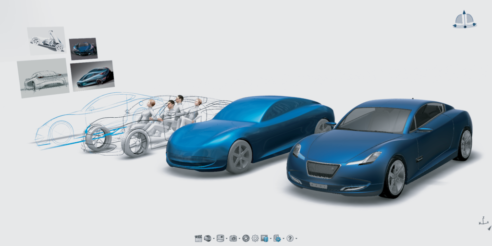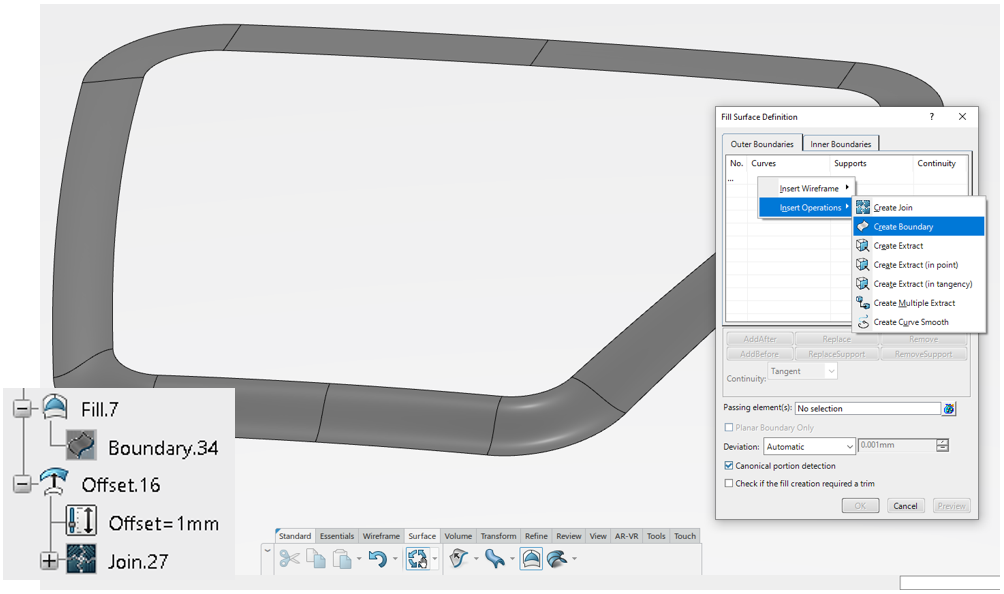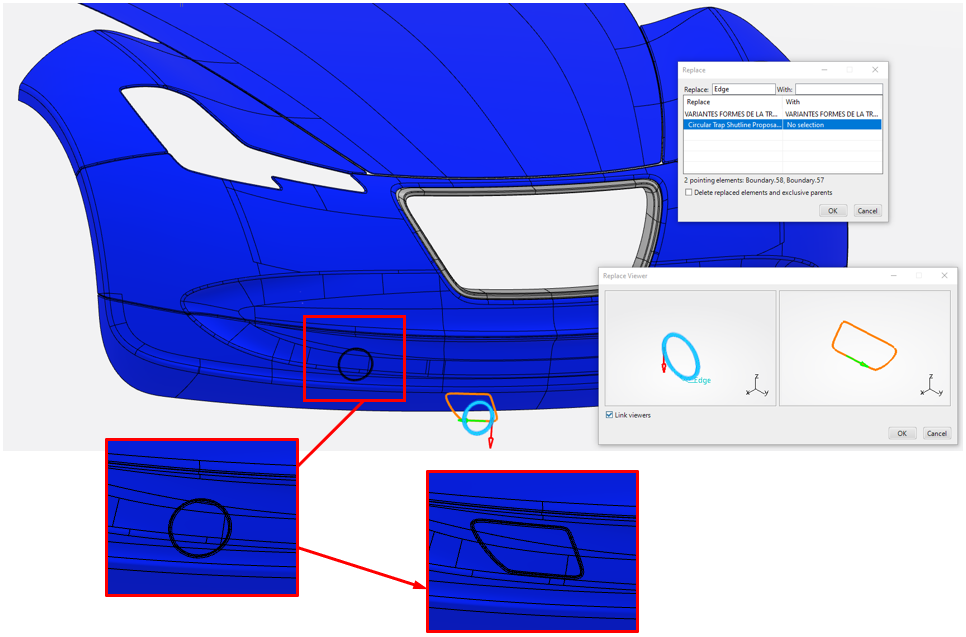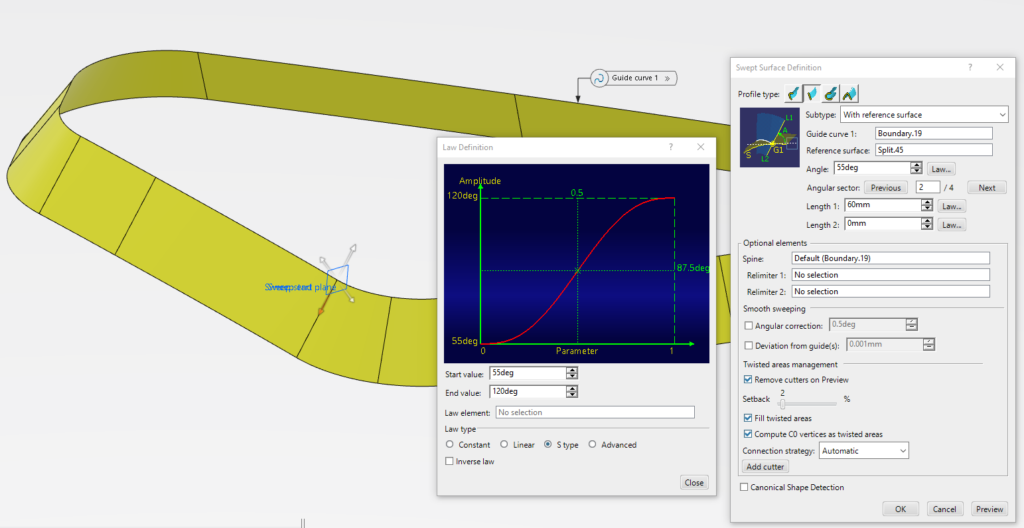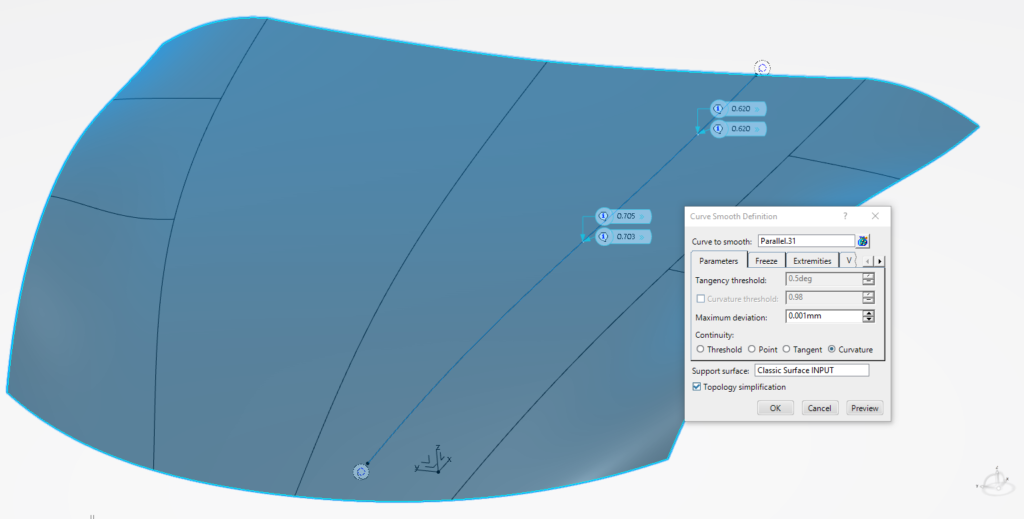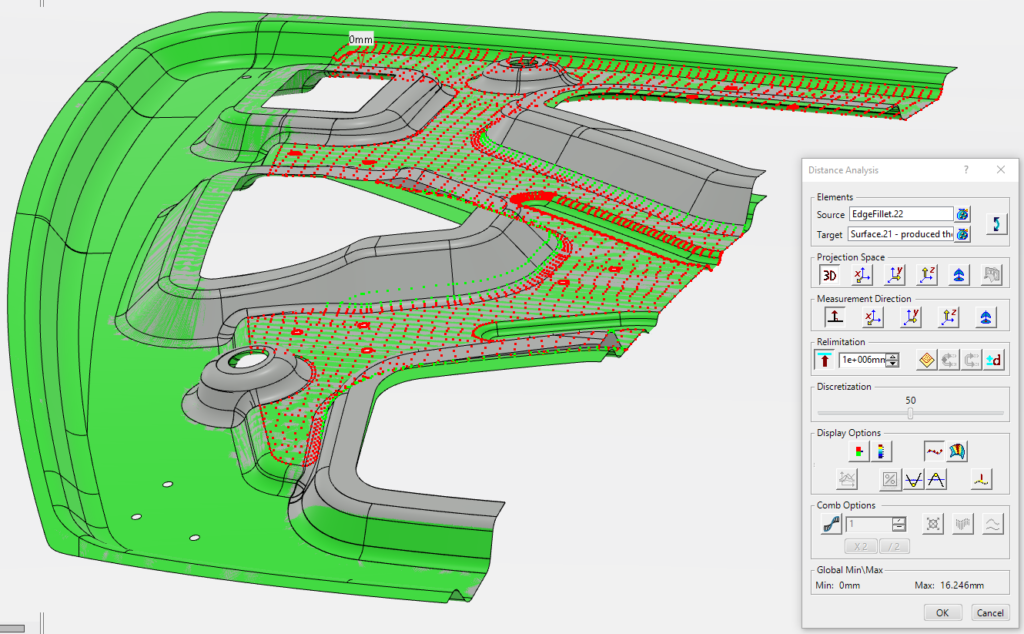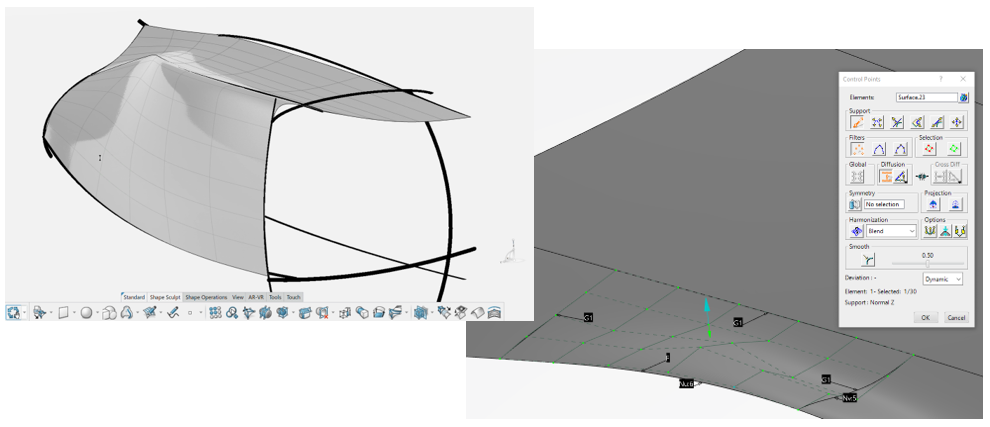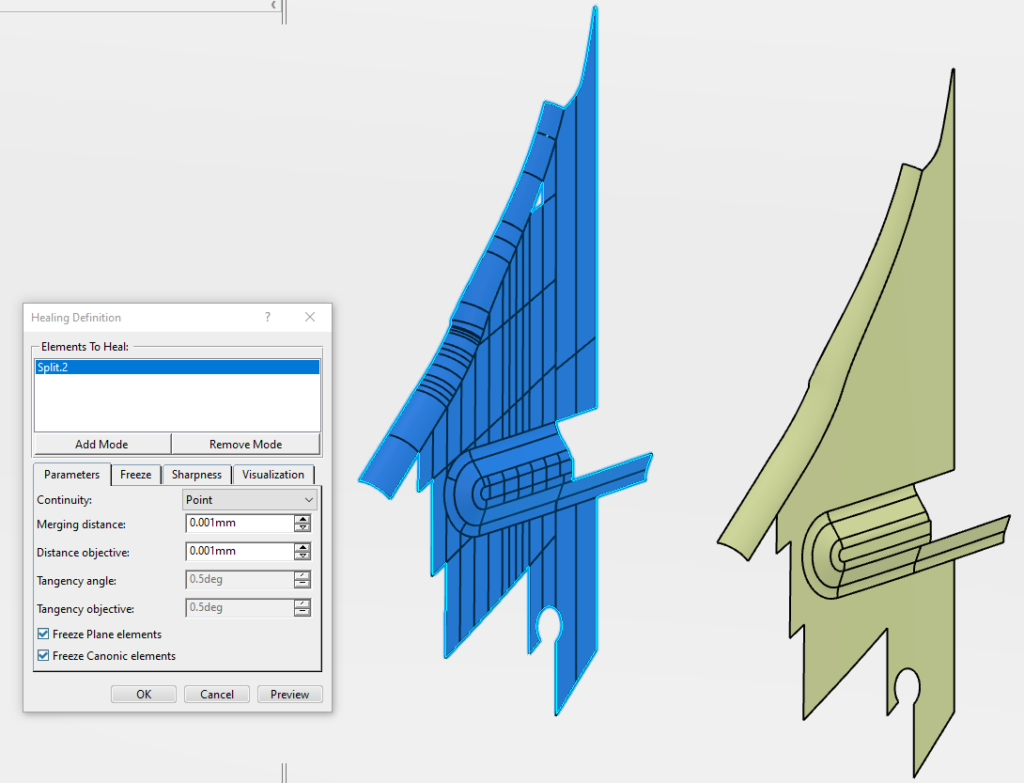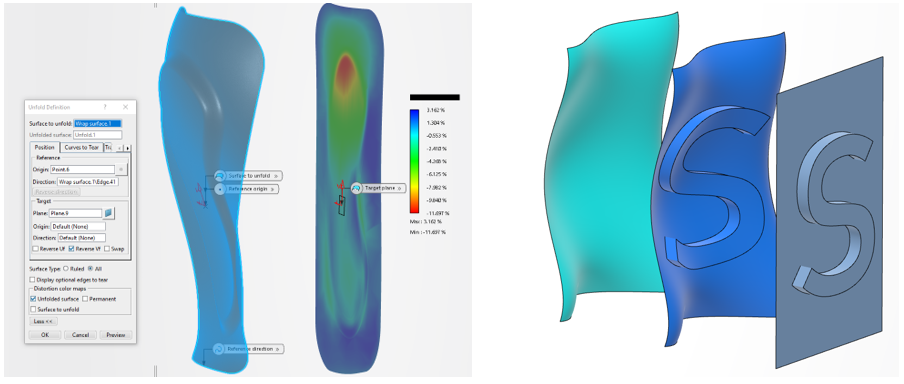Dassault Systèmes has made it easy for SOLIDWORKS and other mid-range CAD users to transition to CATIA 3DEXPERIENCE and benefit from an expanded selection of powerful design tools to harness its superior surface modeling capability.
Intuitive User Interface
Users get the power of CATIA 3DEXPERIENCE with an intuitive SOLIDWORKS-like user interface:
- Contextual options dependent on user selection similar to SOLIDWORKS
- Convenient user profile change from CATIA to SOLIDWORKS to adjust 3D model manipulation
- Many commands with icons that are identical to their SOLIDWORKS counterparts
- Feature creation dialogue boxes that are very similar in appearance and layout to their SOLIDWORKS counterparts
For more details on how CATIA on the 3DEXPERIENCE platform accommodates and benefits SOLIDWORKS users, check out our companion blog post.
Superior Surface Modeling Capability
Across a wide range of surface modeling solutions for parametric and free form surface creation, new CATIA 3DEXPERIENCE users can quickly adapt to efficiently model high-quality surfaces thanks to the ability to:
Define curve and surface continuity
Regardless of the surfacing application being used, it is possible through most surfacing commands to control the curve-curve and surface-surface continuity through point, tangency, and curvature to generate Class-A quality surfaces. For a given continuity condition between curves, surfaces and their supports, users can also optimize their designs by adjusting the tension values across the joint interface.
Organize and simplify the design spec-tree
Surface modeling by nature is a process that can introduce many elements to the design spec-tree, but the availability of Geometrical Sets ensures that these elements can be contained and organized within them. In so doing, users can refine the tree structure to improve tree navigation and downstream model error diagnosis. By maintaining total design flexibility, CATIA enables users to create either non-ordered or ordered geometrical sets depending on their preference as well as to contain surface model elements within solid bodies in a hybrid design mode.
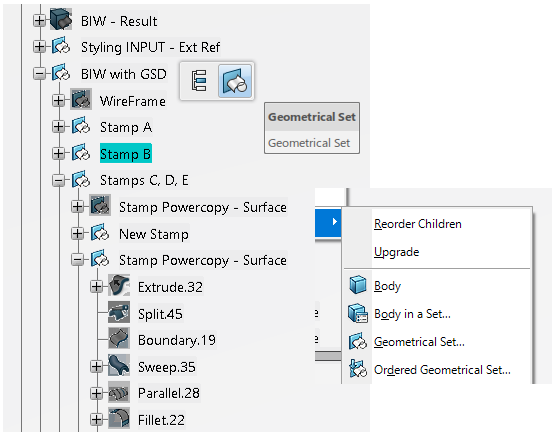
Stack commands
Design progress does not depend on the availability of pre-existing geometry. Necessary geometry can be created on the fly within active commands to effectively reduce the model development time, and not impede the overall process. In addition, the utilization of command stacking further simplifies the spec-tree structure and contributes to the improved organization.
Replace geometry with ease
Replacement of linked elements is conveniently guided by CATIA as it presents the user with a separate split window identifying the original input geometry and assisting with their redefinition.
Control model update behavior
A choice between automatic and manual model update enables users to select the proper regeneration method depending on the present scenario. Manual update mode provides maximum control to selectively update certain elements resulting in effective management of any model inconsistencies and resolution of potential errors. Any surface design modifications can be targeted with precision without forcing any global disruptions, ultimately delivering a design environment that promotes the creation of robust and stable surface models.
Control surface variance and refinement
User-defined laws can be introduced to the model to define the variance of surfaces and foundational wireframe. These law-based relations are embedded in certain commands as well to offer the user total control over the output geometry. A mix of associative and non-associative geometry ensures a smooth modeling process where parametric surfaces can be refined further using non-associative surfacing tools.
Clean curves and surfaces to generate higher quality
Elimination of undesirable curve nodes can be achieved with curve smoothing operations, that can be combined with smoothing operations embedded in various surface generating commands to ensure the creation of clean and continuous surfaces free of any defects.
Compare surface and curve data
As design changes take place, users can preserve the current state of the model surfaces to gauge the effect of these changes. This can be easily achieved through the creation of non-associative reference surfaces to capture the current design intent, before comparing using various simple and advanced analysis tools.
Model stylized and industrial product surfaces in free form
Exercise maximum creativity by constructing and reshaping surfaces using node manipulation. Non-parametric NURBS surfaces offer an efficient method to generate aesthetically appealing shapes, and to adjust complexity through UV parameterization of curve and surface orders. Alternatively, users can create curvature continuous parametric subdivision surfaces before optimizing through node manipulation. The resultant exact surfaces can be derived from free hand 2D and 3D sketches or photos if needed. Other creative design tools enable product development engineers to integrate the design within the context of the human.
Heal and simplify imported surfaces
Imported surfaces can be analyzed to check their gaps and other discontinuities, before properly healing and repairing them. Surfaces constituting multiple patches can be simplified into a single unified surface that can then be processed downstream without issue.
Flatten and morph shapes
Easy flattening of complex surfaces is possible while retaining the ability to map geometry from folded to unfolded surfaces and vice-a-versa. Shape morphing can be achieved through dedicated commands where complete surfaces can be driven by certain reference and target geometry to alter their shapes and conform based on the underlying reference-target relation.
The seamless integration of all other applications on the 3DEXPERIENCE platform always ensures a continuous and hassle-free process workflow across all modeling disciplines. A higher level of continuity and more advanced surface modeling options are available through premium ICEM surface design tools.
Questions?
If you have any questions or would like to learn more about CATIA 3DEXPERIENCE, call Inceptra at (954) 442-5400 or submit an online inquiry.

